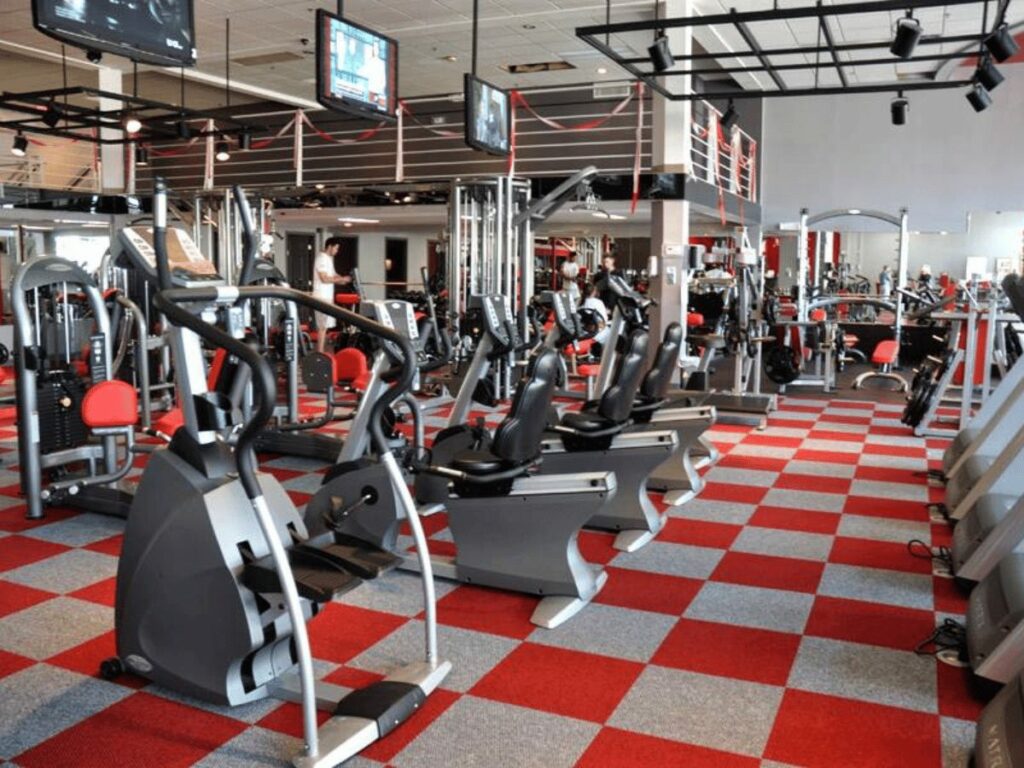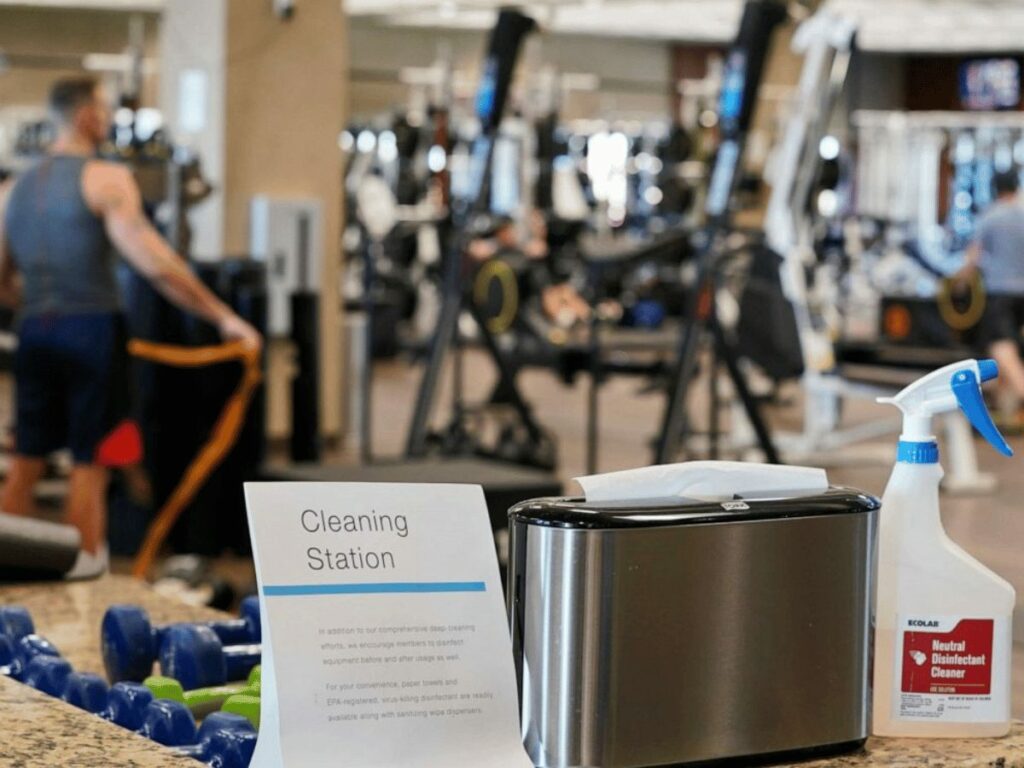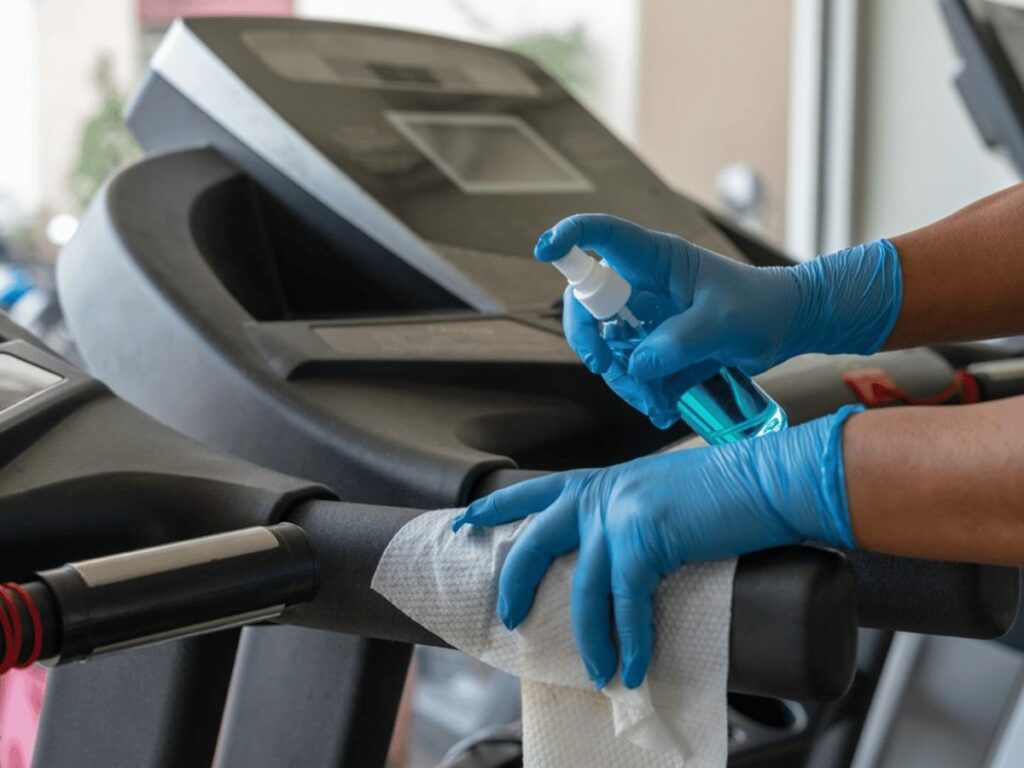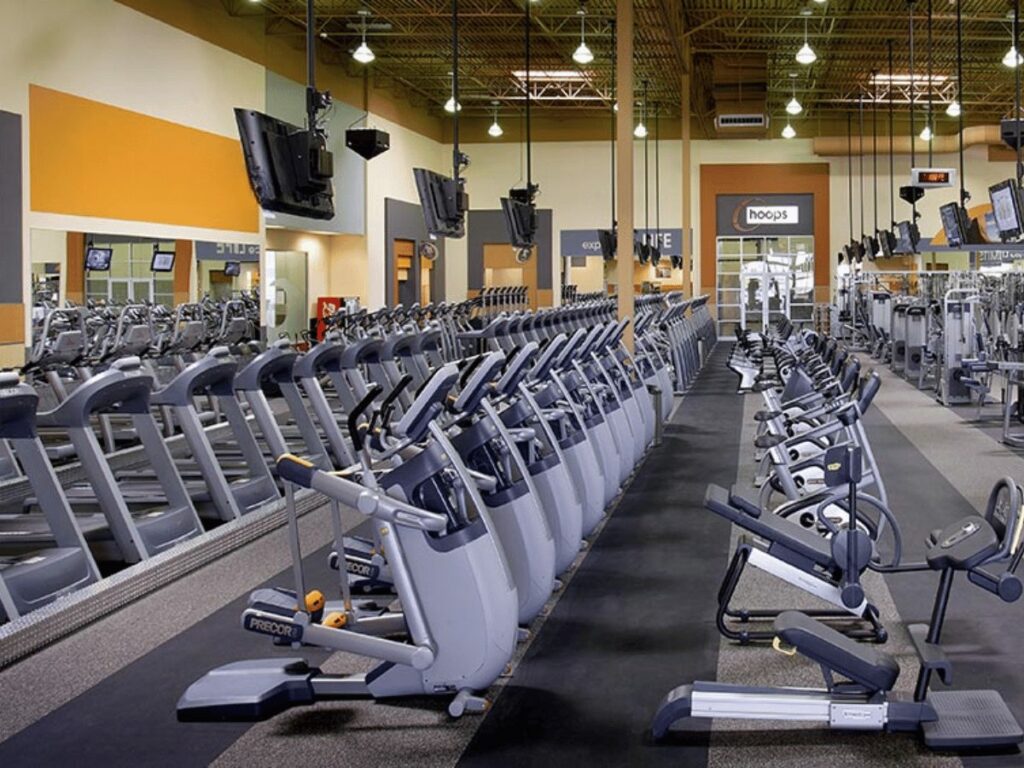Do you want to ensure your gym operates at peak performance while providing a safe environment for your clients? It’s crucial to conduct regular inspections to maintain the quality and reputation of your fitness facility. However, developing a thorough gym inspection checklist can be a daunting task.
In this article, we meticulously crafted a gym inspection checklist designed to help you manage a gym and identify and address potential issues. With our comprehensive guide, you’ll be well-equipped to keep your gym in tip-top shape and prevent any costly problems down the line.
Read on to discover how our gym inspection checklist can help you maintain a safe, efficient, and successful fitness facility.
Table of Contents
1. Physical Infrastructure
An essential foundation of any gym is its physical infrastructure. This includes everything from the floors to the ceilings, ensuring that the environment is safe, conducive, and functional for various fitness activities. Having been through several inspections myself, I can’t stress enough how crucial this aspect is for a gym’s success.
Floor
A gym’s flooring needs to be durable, slip-resistant, and able to withstand heavy equipment and high traffic. It should also be easy to clean. Rubber flooring,for example, is popular in many gyms due to its durability and shock absorption properties. As a best practice, inspect the floor for any wear and tear and ensure it is free from any debris.
Walls and Ceilings
Walls should be painted with durable paint that can withstand wear and tear. Mirrors can be installed to help patrons observe their form during exercises. The ceiling should be high enough to accommodate various equipment and exercises. Additionally, the walls and ceilings should be inspected for any leaks or damages, especially after severe weather.
Ventilation
Proper ventilation is crucial in any gym. It helps to ensure that there is a constant flow of fresh air, which is vital for the comfort and health of the patrons. Installing air conditioning and ensuring that vents are clean and functional is essential. Gym owners must ensure that the HVAC system is serviced regularly.
Lighting
Proper lighting is necessary for the safety and functionality of the gym. It should be bright enough to see clearly but not so bright as to be harsh or cause glare. Using LED lights can be a good option as they are energy efficient and have a longer lifespan.
Sanitation Facilities
Ensure that the gym has adequate sanitation facilities including showers, toilets, and sinks. These should be regularly cleaned and maintained. In my experience, nothing turns patrons away faster than unsanitary conditions.
Emergency Exits
A gym must have clearly marked emergency exits. These exits should be free of any obstructions and should be easily accessible in case of an emergency. Regular drills and inspections are essential for safety. According to Vector Solutions, there are three parts of an exit route:
- Exit access: refers to the segment of a path that guides to an exit. OSHA mandates a minimum width of 28 inches for exit access at all points.
- Exit: This is an area typically isolated from other sections to create a safe passage leading to the exit discharge.
- Exit discharge: This is the section that connects directly to an outdoor area or to a street, pathway, safe space, public thoroughfare, or any open area that leads outside
2. Gym Equipment
Gym equipment is the backbone of the facility. Ensuring they are in the best condition is crucial for the gym’s reputation and for the safety of the patrons. Many gym owners found that high-quality equipment, such as those from Yanre Fitness, makes a world of difference.

Cardio Training
Cardio training equipment such as treadmills, elliptical trainers, and exercise bikes must be in good working condition. Regular maintenance, such as checking for any loose parts, is necessary. It is also advisable to have varied types of cardio equipment to cater to different preferences.
Strength Training
For strength training, ensure that the gym has a range of equipment including weight machines, benches, and resistance bands. Most gym goers choose some popular equipment in the gym like weight machines which are known for their durability and user-friendly design.
Functional Training
Functional training equipment like kettlebells, stability balls, and TRX systems should be inspected for any wear and tear. It is essential that these items are of high quality as they are used for exercises that mimic everyday activities.
Free Weights
Free weights such as dumbbells and barbells should be regularly checked for any signs of damage. It’s important to ensure that the grip is secure and that there are no loose parts. Statistics show the number of users of free weights (dumbbells/hand weights) in the United States from 2013 to 2021. In 2021, the number of users (aged six years and above) of dumbbells/hand weights amounted to approximately 52.64 million.
Mat Inspection
Ensuring the cleanliness of exercise mats is vital, as well as inspecting them for any signs of tearing or damage. Additionally, I believe the mats should have sufficient thickness to offer the necessary cushioning for various exercises.
Specialized Equipment
It’s imperative to confirm that specialized equipment, such as punching bags or rowing machines, is in excellent condition, especially for gyms offering specialized training like boxing or CrossFit. For example, a gym that holds boxing classes needs to make sure that the boxing gloves are not only clean but also free from any wear and tear.
Gym Accessories
Small accessories should not be overlooked during gym inspections. In my experience, these items need to be in good condition, and any showing signs of wear should be promptly replaced.
- Metallic Fitness Sipper: Including metallic fitness sippers in gym inspections is crucial. As fitness enthusiasts need to stay hydrated during workouts, it’s imperative to regularly check these sippers for cleanliness and any signs of damage.
- Yoga Mat: Regular inspection of yoga mats helps in detecting any wear and tear, ensuring that the mats provide adequate cushioning and are free from any hygiene issues.
- Gym Ball: Gym balls are versatile pieces of equipment and need to be part of gym inspections to ensure they are free of punctures and are properly inflated. This is crucial because a compromised gym ball can be unstable and may cause injuries to members engaging in exercises that require balance and stability.
- Skipping Rope: Skipping ropes are integral for cardiovascular exercises, and must ensure they are in good condition with no fraying or kinks. This is important because a faulty skipping rope can cause trips and falls, compromising the safety of the members.
- CRM Tool for Gym Pass Management: By regularly monitoring the CRM tool, gym owners can ensure that members’ data is secure, and there are no glitches in managing bookings and access, thereby maintaining a well-organized and efficient gym environment
3. Health and Safety Measures
Health and safety are paramount in any gym setting. It is important to ensure that all measures are in place to deal with any emergencies and to ensure the safety of the patrons. Let’s discuss the important details below:

First Aid Kit
A well-stocked first aid kit is essential in every gym to attend to minor injuries or stabilize a person in case of severe injuries until professional help arrives. It’s important to ensure that the first aid kit is fully stocked, with valid contents, and that incident reports are available and completed on a weekly basis.
Here are First Aid Kits that a gym business should have:
- First Aid Medi Kit: This First Aid Medi Kit is small and compact, designed for general use. It contains essentials that are needed for minor wounds, cuts, and grazes. The kit is affordable and highly portable.
- First Aid Outfit MOM Box A: This is one of the most popular first aid kits used in workplaces. It’s a part of the series (Box A, B, C) which is considered a benchmark by employers when selecting first aid kits. The contents of this kit are suitable for a variety of injuries and emergencies.
- Emergency Eye Wash Kit: An Emergency Eye Wash Kit is essential for a gym where particles or chemicals could get into someone’s eyes. This kit is lightweight and portable, and it provides immediate and effective eye irrigation in case of eye injuries.
- First Aid Pouch Red Medium: This is a medium-sized red/black canvas bag that is suitable to carry a good amount of first aid supplies on the go. It has a large zipped compartment for easy access and elastic netting inside the bag.
- Dyna Med Mini-Medic Bag MB060: This Mini-Medic Bag is designed for the first person on the scene of an injury. It is constructed with 1000 denier nylon and has a waterproof bottom. The bag is spacious enough to hold various tools, instruments, and supplies needed for rapid treatment delivery.
Fire Safety
Personally, I can tell fire safety measures, such as fire extinguishers and alarms, should be in place. In addition, building evacuation floor plans should be available and displayed to guide individuals during emergencies. According to RedCross, during a fire, early warning from a working smoke alarm plus a fire escape plan that has been practiced regularly can save lives.
Safety Signage
Safety and operational signage must be installed throughout the gym, and it’s necessary to ensure that all high-risk activities have a current safety procedure that has been provided to staff and gym members. This includes prominently displayed signs indicating where first aid kits, and fire extinguishers are located, as well as caution signs for wet floors.
Accessibility
From my point of view, ensuring a gym is accessible for individuals with disabilities is not only a matter of compliance but also of inclusion. This involves providing features like ramps, wider doors, and accessible equipment, as well as ensuring the site has adequate disability access.
4. Hygiene and Cleanliness
Maintaining a high level of hygiene and cleanliness in the gym is non-negotiable. This is important not only for the health of all patrons but also for the reputation of the gym. Here are some important things to take note of.

Regular Cleaning Schedule
Ensuring that the gym has a regular cleaning schedule is imperative. This should encompass daily cleaning of floors, equipment, and sanitation facilities. I believe it is important to have scheduled deep cleaning sessions every week to maintain a fresh environment. Additionally, cleanliness and hygiene in gyms are crucial for both comfort and safety.
Cleaning Materials
Possessing the right cleaning materials is indispensable. In most gyms, eco-friendly cleaning products are preferred. A robust gym health and safety checklist template can aid in delegating tasks for efficient cleaning while adhering to Work Health and Safety (WHS) standards.
- Disinfectant Wipes: These are quick and convenient for disinfecting surfaces in a gym. It’s important to have disinfectant wipes that are effective in killing germs, bacteria, and viruses.
- Microfiber Mops and Pads: Using disposable microfiber mop pads is recommended. Microfiber is known for its ability to capture dirt and bacteria effectively.
- Cleaning Cloths: Cleaning cloths are essential for wiping down surfaces and equipment. They can be used with cleaning solutions to remove grime and sweat.
- Multipurpose Natural Cleaner: It’s important to have a natural cleaning solution that is safe for both the equipment and the individuals using the gym. Some multipurpose natural cleaner involves turning tap water, salt, and vinegar into a cleaner.
- Personal Protective Equipment (PPE) for Cleaning Staff: It’s important for cleaning staff to wear personal protective equipment such as gloves and masks while cleaning. This ensures that they are protected from chemicals and germs while also preventing any cross-contamination during the cleaning process.
Disinfectant Stations
Establishing disinfectant stations across the gym is highly recommended. This grants patrons the opportunity to sanitize equipment before and after use. A shining instance is Yanre Fitness, which not have quality fitness equipment but also incorporates sanitizing solutions. Moreover, gym equipment should be wiped down with a disinfectant after each use to maintain hygiene standards.
Waste Management
Efficient waste management is of paramount importance. Ensure that bins are cleared frequently and that there is a structured system for the disposal of general waste and recyclables. I have seen in my gym segregating waste into different categories for recycling is a key practice.
- Ensuring Regulatory Compliance in Solid Waste Management
- The gym, being a commercial establishment, generates solid waste which, if not managed properly, can have detrimental effects on the environment and public health.
- As per the law, it is imperative for the gym to adhere to waste management regulatory standards, and this can be evaluated by including a solid waste management checklist in the gym inspection.
- Mitigating Environmental and Health Risks through Proper Waste Disposal
- Solid waste generated in the gym, such as plastics, papers, or metals, needs to be managed efficiently to eliminate potential hazards like environmental pollution, pathogenic diseases, and toxic chemical reactions.
- Gym inspection checklists must include waste disposal protocols to ensure that waste does not contribute to pollution or pose health risks to gym members and staff.
- Implementing a Waste Audit for Continuous Improvement
- A waste audit, which involves reviewing and analyzing the waste produced by the gym, is essential for identifying the sources and types of waste, and for discovering recycling opportunities and improving waste management systems.
- Including a waste audit in the gym inspection checklist ensures that the establishment continuously improves its waste management processes, which can lead to cost savings and a smaller environmental footprint.
5. Benefits of Digitalizing Gym Maintenance
By leveraging digital solutions, gym owners can efficiently schedule and track maintenance tasks, thereby enhancing equipment reliability, ensuring customer safety, and optimizing operations to stay competitive. Here are six benefits to explore:

Safety Measures
Automated systems can alert gym owners when an inspection is due, ensuring that gym equipment is consistently reliable and safe for patrons. Moreover, digital maintenance management can document safety checks, which is vital in safeguarding the gym from liabilities concerning injuries attributable to faulty equipment.
Quality Control
Digitalized maintenance ensures that gym equipment and facilities are consistently clean and in pristine condition. Through digitalized task tracking and standard operating procedures, gym facilities can remain free from hazards and litter, thus boosting customer satisfaction and retention. Keeping clients content and being impressed with the quality of the facility will lead to positive feedback, which is pivotal for business success.
Extended Equipment Life
Employing a digital maintenance system in gym management contributes to lengthening the life span of the equipment. Consistent monitoring ensures that maintenance tasks are executed on time and at the correct intervals, which minimizes wear and tear, and ultimately mitigates costly repairs or replacements. I truly believe the longevity of equipment is a key element in protecting a gym’s bottom line.
Reduced Equipment Downtime
Digitalized maintenance programs can instantly deploy protocols when equipment fails, thus reducing downtime. The ability to swiftly resolve issues and get the equipment back in operation is essential in ensuring that members perceive the gym as reliable and worth their membership fee. Extended downtime could prompt members to reconsider the value of their membership, so minimizing it is key.
The table below highlights the advantages of digitalized maintenance programs in reducing equipment downtime at gyms. Discover how swift issue resolution, improved member perception, and proactive maintenance contribute to enhanced equipment availability, streamlined repair processes, and increased member satisfaction, ultimately minimizing disruptions and optimizing gym operations.
| Benefits | Description |
| Swift Issue Resolution | Digitalized maintenance programs allow for instant deployment of protocols when equipment fails, enabling swift issue resolution and minimizing downtime in the gym. |
| Improved Member Perception | Minimizing equipment downtime demonstrates reliability and ensures that members perceive the gym as dependable and worth their membership fee, fostering positive member experiences. |
| Enhanced Equipment Availability | By reducing downtime, digitalized maintenance programs ensure that gym equipment is readily available for members to use, maximizing equipment usage and preventing disruptions to workouts. |
| Preventive Maintenance | Digitalized maintenance programs facilitate proactive measures, allowing for preventive maintenance to identify and address potential issues before they lead to equipment failure and significant downtime. |
| Streamlined Repair Processes | Implementing digitalized maintenance programs streamlines repair processes, enabling efficient communication, task assignment, and tracking, resulting in quicker equipment repairs and reduced downtime. |
| Data-Driven Decision Making | Digital maintenance systems provide valuable data and insights into equipment performance, usage patterns, and maintenance needs, allowing for data-driven decision making to optimize equipment uptime. |
| Efficient Resource Allocation | By promptly resolving equipment issues, digitalized maintenance programs help optimize resource allocation, ensuring that repairs and maintenance tasks are prioritized based on urgency and impact on member experience. |
| Increased Member Satisfaction | Reduced equipment downtime enhances member satisfaction by minimizing disruptions to their workouts, allowing them to have a consistent and uninterrupted gym experience. |
| Cost Savings | Minimizing equipment downtime through digitalized maintenance programs can lead to cost savings by preventing major breakdowns, reducing the need for extensive repairs or equipment replacements. |
Scheduling and Automation
With digital solutions, maintenance schedules, and reminders for regular servicing, cleaning, and repairs can be set up for each piece of equipment. I can tell personally this significantly boosts efficiency, lessening the reliance on manual systems that are prone to error, and ensuring that no maintenance task is overlooked.
Informed Decision-making
Digitalized maintenance systems allow gym owners to effortlessly track equipment usage, maintenance, and repair costs. The system can generate reports which can be analyzed for trends and insights. Such information is invaluable in making well-informed decisions that can enhance the efficiency of the maintenance program and contribute positively to the gym’s overall performance.
6. Conclusion
A comprehensive gym inspection checklist is essential for ensuring the safety, efficiency, and longevity of your fitness facility. By regularly evaluating equipment, cleanliness, and maintenance, you can create an optimal environment for your clients, staff, and business.
Don’t miss out on the opportunity to elevate your gym’s standards. Contact us at Yanre Fitness today to learn more about our premium equipment and services. We’ll gladly provide you with product details, catalogues, price lists, and expert assistance to help you make informed decisions for your fitness center.
Related articles:








